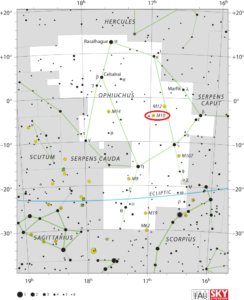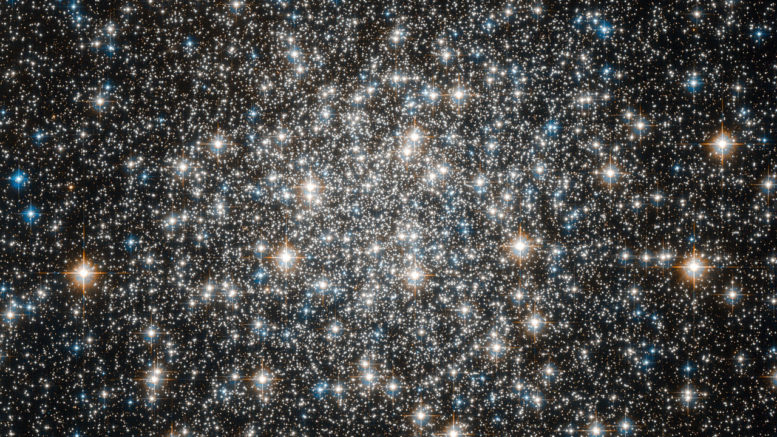Messier 10 is notable for its high population of blue stragglers, which are stars that appear to be far younger than their neighbors. These stars in globular clusters are thought to have formed and aged together, so they should all be roughly the same age; however, these anomalous, bluer stars were created either by collisions between stars or other stellar interactions.
| Description | |
| Visible From Pacific Northwest | |
| Best Time To Observe | July |
| Minimum Size Of Viewing Device | |
| Object Type | Globular Cluster |
| Designations | Messier 10, M10, NGC 6254, GCl-49 |
| Right Ascension | 16h 57m 8.92s |
| Declination | -04°05’58.07” |
| Constellation | Ophiuchus |
| Number Of Stars | 100,000 |
| Apparent magnitude | +6.4 |
| Apparent dimensions | 20′ |
| Object Radius | 41.6 light years |
| Distance From Earth | 14,300 light years |
History
The object was discovered by the French astronomer Charles Messier on May 29, 1764, who cataloged it as number 10 in his catalogue and described it as a “nebula without stars”. In 1774, German astronomer Johann Elert Bode likewise called it a “nebulous patch without stars; very pale”. Using larger instrumentation, German-born astronomer William Herschel was able to resolve the cluster into its individual members. He described it as a “beautiful cluster of extremely compressed stars”. William Parsons, 3rd Earl of Rosse thought he could distinguish a dark lane through part of the cluster. The first to estimate the distance to the cluster was Harlow Shapley, although his derivation of 33,000 light years was much further than the modern value.
Locating M10 In The Sky
Messier 10 can be found by astronomers by looking roughly half a handwidth west of the bright star Beta Ophiuchi, which is also known as Cebalrai, with Messier 10 lying a bit lower in the sky, to the south of M12. M10 lies along the line from Cebalrai to Zeta Ophiuchi, the third brightest star in Ophiuchus. It is only a degree away from 30 Ophiuchi, an orange giant star with an apparent magnitude of 4.83.

Viewing M10
small telescopes (3-inch) reveal about half the cluster’s size – roughly 8 to 9 minutes of arc – and its bright central region, which spans roughly 35 light years. 6-inch or 8-inch telescopes show the cluster extending across 15.1 arc minutes and reveal a large, bright central core. Meanwhile, deep images reveal M10 to span some 20 arc minutes of apparent sky and resolve stars across the entire area of the cluster.
Photographing M10
For those who are looking too photograph M10, the good news is that it is indeed possible using a DSLR. Using a camera similar to a Canon Rebel T2i with a Baader UV/IR filter, one can obtain a beautiful photo of M10 using only 2 shots at 300s each, with f/2.8, and ISO 800.
Sources And Further Reading
Descriptions of all of Messier Objects can be found here.
https://www.nasa.gov/feature/goddard/2017/messier-10

Thank you for sharing this information. You guided me well
have visited this cool site a few times now and I have to tell you that I find it quite great actually. Keep it up!